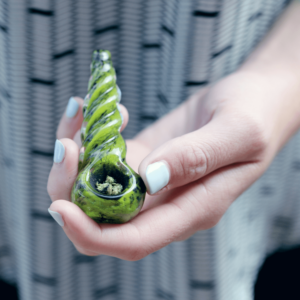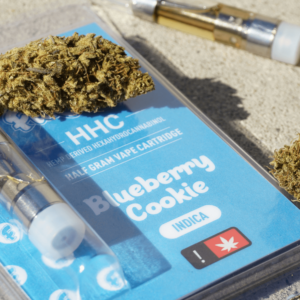Welcome to our guide to HHCP, where we’ll break down what is HHCp and what it’s is all about.
HHCP, short for Hexahydrocannabinol acetate, is making waves in various fields, from healthcare to recreational cannabinoid products. Its significance lies in its potential as a novel cannabinoid that offers unique properties that draw the attention of researchers and consumers alike.
In fields like medicine, HHCP is explored for its potential therapeutic benefits, while in the world of wellness, it’s being tested in innovative product developments. As you read through this blog, expect to discover the basics of what HHCP is, understand why it’s capturing interest in these different areas, and learn about its future possibilities.
We’ve got plenty of insights lined up, just waiting to be revealed, so sit back, relax, and let’s dive into the world of HHCP together.

What Does HHCP Stand For?
HHCP is a newly discovered cannabinoid alternative. HHCP stands for Hexahydrocannabinol acetate, a compound with growing prominence in various industries. The acronym HHCP is derived from its chemical structure, indicating it as a hydrogenated derivative of tetrahydrocannabinol (Delta-9 THC).
Typically found in debates about hemp plant cannabinoids like THCa (a naturally occurring cannabinoid found in the hemp plant), HHCP is often mentioned alongside other hemp-derived products and synthetic cannabinoids. Its unique properties have sparked curiosity among researchers and consumers, resulting in increased exploration across the health, wellness, and recreational sectors.
Whether you’re hearing about it in a scientific forum or a casual discussion about the latest cannabinoid trends, HHCP is making its mark.
Historical Background of HHCP
The journey of HHCP from a lesser-known compound to a subject of interesting discussions is quite fascinating. It all began when researchers dove into the potential of cannabinoids, leading to the eventual synthesis of HHCP as a promising variant. Unlike its more famous cousins, Delta 9 THC and CBD, HHCP started to gain attention due to its distinct properties and potential applications.
A significant milestone in its development was the early experimental studies exploring its psychoactive effects, which opened doors for further research into its diverse uses. Prominent organizations and research institutions have since taken an interest in mapping out its full range of health benefits, particularly in therapeutic contexts.
Researchers pioneered its isolation and classification, aiming at harnessing its properties for both medicinal and recreational purposes. Over time, HHCP has evolved with advancements in potent cannabinoid research, reflecting broader trends in how society seeks to understand and utilize these natural compounds. This tale of evolution continues as more discoveries are made, promising an exciting future for HHCP in various fields.
Core Principles of HHCP
Understanding the core principles of HHCP is like peeling back the layers of an onion; at its heart, HHCP is all about chemistry and biology. This semi-synthetic cannabinoid is fundamentally defined by its distinctive molecular structure as a hydrogenated derivative of tetrahydrocannabinol (THC). This structure not only differentiates HHCP from other cannabinoids but also gives it unique properties that make it a subject of intense study.
- Hydrogenation Process: Converts Delta 9 THC to HHCP, potentially altering its psychoactive effects and stability.
- Biological Interaction: Interacts with receptors in the endocannabinoid system and cannabinoid receptors of the human body, leading to varying physiological responses.
These principles are crucial because they form the foundation for understanding how HHCP functions and what potential it may hold across different applications. Without grasping these basics, it would be challenging to appreciate or utilize the compound’s full capabilities effectively.
Applications of HHCP
HHCP is carving out niches in several exciting areas, thanks to its unique profile. Its primary applications span both medical and wellness sectors, attracting attention for its potential therapeutic benefits.
- Medical Field: Researchers are exploring HHCP for pain management and as an anti-inflammatory agent. Its distinct properties make it an intriguing alternative for patients seeking options beyond traditional THC or CBD.
- Wellness Products: Emerging in health and beauty products, HHCP is being used in innovative formulations like skincare and relaxation aids. These products capitalize on HHCP’s unique interaction with the body, promising new experiences for consumers.
Notable projects include studies conducted by research institutions investigating HHCP’s efficacy in specific clinical settings. These projects underscore the growing interest and potential for HHCP in revolutionizing cannabinoid-based treatments.

Benefits of HHCP
HHCP brings a bunch of cool benefits that can shake up different industries. The most exciting part? It can really boost efficiency and spark fresh ideas in product development. Let’s explore how this could actually make things better!
- Efficiency: By offering a more stable compound compared to traditional cannabinoids, HHCP can be incorporated into products with a longer shelf life and consistent performance.
- Productivity: Its unique properties might lead to more effective therapeutic applications, providing alternatives where current options may be limited.
Moreover, HHCP represents a clear improvement over previous methods by providing a diversified approach to cannabinoid utilization. Its innovative edge could pave the way for new breakthroughs in both medical and recreational use.
Challenges and Limitations
Despite its promise, the adoption of HHCP comes with its own set of challenges. Regulatory barriers often slow down research and development efforts, limiting how quickly HHCP can be tested and brought to market.
- Regulatory Concerns: Varied regulatory landscapes make it difficult for researchers and manufacturers to standardize and distribute HHCP products.
- Scientific Understanding: While HHCP is promising, there’s still much to learn about its complete effects and long-term implications.
Future improvements could address these hurdles by streamlining testing protocols and harmonizing regulations across regions. Overcoming these challenges would allow HHCP to reach its full potential, impacting a broader range of applications and benefiting more people.

Current Trends in HHCP
In recent years, HHCP has seen a surge of interest within the research community, largely fueled by advancements in extraction and synthesis technologies.
New isolation and refinement methods have significantly improved the quality and HHCP potency, making it a more viable option for both medical and recreational uses. These cutting-edge technologies have not only streamlined production but also enhanced the efficiency with which HHCP can be incorporated into various products.
Additionally, there’s a growing trend of using sustainable practices in the cultivation and processing of HHCP, aligning with broader environmental concerns. As researchers continue to explore its potential, the ongoing developments in HHCP promise to foster even more innovative products in the near future, further cementing its role in the evolving cannabinoid market.
Future Prospects of HHCP
Looking towards the future, HHCP holds promising potential to expand beyond its current applications. The next decade could see HHCP finding its niche in diverse sectors such as pharmaceuticals, food and beverage, and even horticulture.
Emerging research suggests that HHCP might offer novel solutions for chronic pain management, mental health conditions, and inflammatory diseases, positioning it as a cornerstone in new therapeutic protocols. Beyond health, HHCP’s stability and unique interaction profile open possibilities for its use in environmentally friendly agricultural products, promoting sustainable crop growth.
As regulatory landscapes evolve to accommodate novel cannabinoids, the commercial viability of HHCP-enhanced goods will likely increase, capturing the attention of manufacturers looking for competitive edges.
Moreover, the anticipated breakthroughs in cannabinoid synergy could unlock synergies with other compounds, heightening HHCP’s effectiveness and extending its applications. Therefore, the future of HHCP appears not only dynamic but also pivotal in reshaping multiple industries.

What is the Synthetic Cannabinoid HHCP: Conclusion
In summary, HHCP has emerged as a groundbreaking cannabinoid with multifaceted applications across the medical, wellness, and industrial sectors. Its unique properties, like increased stability and potential therapeutic benefits, set it apart from traditional cannabinoids such as THC and CBD.
Despite facing certain regulatory and scientific challenges, the ongoing advancements in HHCP research and production are paving the way for broader utilization and acceptance. The potential it holds for improving health outcomes and promoting sustainability makes HHCP a topic worth following.
As regulatory landscapes adapt and research progresses, staying informed about developments in HHCP and exploring natural options like THCa flower could offer valuable insights into future trends in the cannabinoid industry.
Frequently Asked Questions
1. Is HHCP stronger than Delta 8?
When it comes to cannabinoids, strength can mean different things, but generally speaking, HHCP is considered to have a more potent effect than Delta 8. This depends on the context and the specific product formulations, but many users and researchers report a noticeable difference in the intensity of the effects.
2. Does HHCP make you high?
Yes, HHCP can produce a high due to its psychoactive properties. However, the experience can vary depending on individual tolerance, the consumption method, and the specific product. It’s always best to start with a small dose to gauge HHCP effects.
3. What’s the difference between HHC and HHCP?
HHC (Hexahydrocannabinol) and HHCP (Hexahydrocannabiphorol) are both cannabinoids, but they differ in their chemical structure and effects. HHCP is known for its stability and potentially stronger psychoactive effects compared to HHC, making it distinct in how it interacts with the body. It’s worth noting that HHC is the hydrogenated form of THC.
4. What is HHCP distillate?
HHCP distillate is a highly purified liquid form of HHCP, often used in various products like edibles, tinctures, and vape cartridges. This distillation process ensures a concentrated form of the cannabinoid, allowing for precise dosage and a cleaner product profile.
5. Is HHCp legal?
The legal status of HHCP products varies depending on the region and its specific regulatory environment. In some countries, HHCP is considered legal due to its distinct chemical composition, while in others, it may fall under broader cannabis regulations which could restrict its sale and use. It’s important for consumers to stay informed about local laws and any changes in legislation related to cannabinoids to ensure compliance with legal standards. Keeping an eye on updates from relevant authorities can help navigate the evolving legal landscape surrounding HHCP.
5. Will HHCP show up on a drug test?
Yes, HHCP has the potential to show up on a drug test. Most standard drug tests are designed to detect THC and its metabolites, and since HHCP is a variant of THC, it may trigger a positive result. However, the extent to which the psychoactive cannabinoid HHCP is detectable can depend on various factors such as the sensitivity of the test, the frequency and amount of HHCP used, and individual metabolism. It’s advisable for those who are subject to regular drug testing to be cautious when using HHCP products and to consider this aspect to avoid unexpected test outcomes.
6. Is Consuming HHCP safe?
Consuming HHCP is generally considered safe when used responsibly, much like other cannabinoids. However, because it’s relatively new, it’s important to approach it with caution. Users should start with a low dose to assess tolerance, and those with underlying health conditions or who are pregnant should consult a healthcare professional before use. Always ensure products are sourced from reputable suppliers to avoid harmful additives.
7. Is HHCP a naturally occurring cannabinoid?
HHCP, or Hexahydrocannabiphorol, is not naturally occurring in cannabis plants. It is a synthetic cannabinoid, meaning it is produced through chemical modifications in a laboratory setting rather than being extracted directly from cannabis. This process allows researchers to enhance certain properties, like stability and potency, distinguishing HHCP from naturally occurring cannabinoids like THC and CBD. As with any synthetic compound, it is crucial to ensure that HHCP products are manufactured in controlled environments to maintain safety and quality standards.





